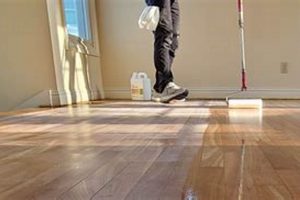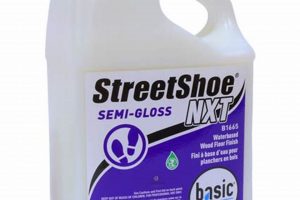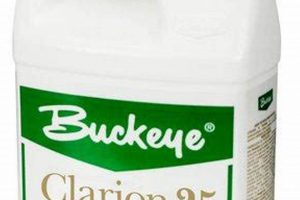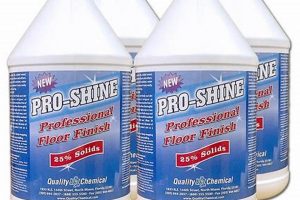The process of applying a protective or decorative layer to a concrete surface to enhance its durability, aesthetics, and functionality is a critical aspect of construction. This layer can involve various techniques and materials, ranging from sealants and coatings to polishing and overlays. For example, applying an epoxy coating to a garage floor not only improves its resistance to stains and abrasions but also enhances its visual appeal.
A well-executed surface treatment extends the lifespan of the underlying structure by shielding it from moisture, chemicals, and physical wear. This contributes significantly to long-term cost savings and reduces the need for frequent repairs or replacements. Historically, these treatments have evolved from simple protective measures to sophisticated methods that offer a wide range of design possibilities, influencing both the functionality and visual character of interior and exterior spaces.
The following sections will detail different types, application processes, and considerations for selecting the optimal method based on specific needs and environmental factors. This will encompass an exploration of the techniques and materials utilized to achieve diverse aesthetic and performance goals in concrete construction.
Essential Considerations for Concrete Surface Treatment
The following are crucial guidelines to ensure the long-term performance and aesthetic appeal of treated concrete surfaces. Careful adherence to these recommendations will maximize the investment and minimize potential complications.
Tip 1: Substrate Preparation is Paramount. Thoroughly clean and prepare the concrete surface before applying any treatment. Remove all dust, debris, oil, and existing coatings to ensure proper adhesion. A poorly prepared surface will compromise the integrity of the applied layer and lead to premature failure.
Tip 2: Moisture Content Evaluation is Essential. Determine the moisture content of the concrete prior to application. Excessive moisture can interfere with the curing process and cause blistering or delamination. Conduct appropriate moisture testing and allow sufficient drying time as needed.
Tip 3: Select Materials Compatible with the Environment. Choose treatments that are appropriate for the intended environment and use. Consider factors such as UV exposure, chemical resistance, and foot traffic when selecting materials. Mismatched materials can result in discoloration, degradation, or safety hazards.
Tip 4: Adhere Strictly to Manufacturer’s Instructions. Follow the manufacturer’s specifications for mixing ratios, application rates, and curing times. Deviations from these instructions can significantly impact the final outcome and longevity of the treatment.
Tip 5: Apply Test Patches Prior to Full Application. Before treating the entire area, apply test patches to a small, inconspicuous section to verify color, adhesion, and overall appearance. This step allows for adjustments and prevents potential issues with the complete surface area.
Tip 6: Ensure Adequate Ventilation During Application. Many treatments contain volatile organic compounds (VOCs). Proper ventilation is essential to minimize health risks and ensure proper curing. Employ appropriate safety measures, such as respirators and ventilation systems, during the application process.
Tip 7: Consider the Long-Term Maintenance Requirements. Understand the maintenance requirements associated with the chosen treatment. Regular cleaning and periodic reapplication may be necessary to maintain the desired appearance and performance over time. Factor these costs into the overall budget.
These guidelines emphasize the importance of careful planning, preparation, and execution in achieving optimal results with concrete surface treatments. Proper application and maintenance will contribute to the durability, functionality, and aesthetic value of the treated surface.
The subsequent sections will further explore specific treatment options and their suitability for various applications, providing a comprehensive understanding of the field.
1. Durability Enhancement
Durability enhancement is a primary objective when considering concrete floor finishing. The application of appropriate treatments significantly extends the lifespan of the concrete substrate and protects it from various forms of degradation.
- Abrasion Resistance
Concrete floors are susceptible to abrasion from foot traffic, machinery, and the movement of objects across the surface. Applying a suitable finish, such as an epoxy coating or a hardener, increases resistance to wear and tear, preventing the formation of dust and extending the floor’s service life. For example, in warehouses, polished concrete with a densifier enhances abrasion resistance against forklift traffic.
- Chemical Resistance
Industrial and commercial settings often expose concrete floors to chemicals, oils, and solvents that can cause corrosion and deterioration. Chemical-resistant coatings, such as polyurethane or epoxy systems, create a barrier that protects the concrete from these harmful substances. A laboratory environment may utilize an epoxy finish to resist spills and maintain a safe, clean workspace.
- Impact Resistance
Impact resistance is crucial in areas where heavy objects may be dropped or dragged across the floor. Certain finishing options, like fiber-reinforced overlays or impact-resistant coatings, can improve the floor’s ability to withstand impacts without cracking or chipping. Manufacturing facilities with heavy machinery frequently benefit from impact-resistant concrete floor treatments.
- Water and Moisture Resistance
Penetration of water and moisture can lead to freeze-thaw damage, efflorescence, and the growth of mold and mildew within the concrete. Applying a sealant or waterproof membrane prevents water intrusion, protecting the concrete from these issues and extending its lifespan. Below-grade concrete slabs often require moisture mitigation systems prior to the application of a decorative finish.
The multifaceted approach to durability enhancement in concrete floor finishing ensures the long-term performance and structural integrity of the concrete. Selection of the appropriate finishing system is dependent on the specific environmental conditions and performance requirements of the space. The careful consideration and application of these elements result in a durable and long-lasting concrete surface.
2. Aesthetic Improvement
Aesthetic improvement is a significant driver in the selection and application of concrete floor treatments. Beyond structural integrity and durability, the visual appeal of a floor contributes to the overall atmosphere and functionality of a space, influencing perceptions and experiences within both residential and commercial environments.
- Color and Pigmentation
The addition of color through integral pigments, stains, or dyes transforms the appearance of concrete floors. Color options range from subtle earth tones to vibrant hues, allowing for customization that complements the surrounding dcor and architectural style. For instance, a retail space might employ a brightly colored epoxy finish to enhance brand recognition and create an engaging shopping environment.
- Texture and Patterning
Various techniques, such as stamping, stenciling, and scoring, introduce texture and patterns to concrete surfaces, adding visual interest and depth. These methods can replicate the look of natural stone, tile, or other materials, providing cost-effective alternatives while offering unique design possibilities. Restaurants frequently utilize stamped concrete flooring to create a rustic or upscale ambiance.
- Surface Sheen and Reflectivity
The level of sheen, ranging from matte to high-gloss, affects the light reflectance and visual impact of a concrete floor. Polished concrete, for example, achieves a high-gloss finish that enhances the brightness of a room and creates a modern, sophisticated look. Museums and art galleries may opt for polished concrete floors to showcase artwork and minimize glare.
- Decorative Aggregates and Overlays
Incorporating decorative aggregates, such as glass, stone, or metallic flakes, into concrete overlays adds texture, color, and dimension to the surface. These materials create visually striking effects and can be customized to match specific design themes. Commercial lobbies and reception areas often feature decorative concrete overlays to create a memorable and impressive first impression.
These aesthetic considerations play a crucial role in the decision-making process when selecting concrete floor finishing options. The ability to customize color, texture, sheen, and design elements allows for the creation of visually appealing and functional spaces that enhance the overall environment. The strategic integration of these elements ensures that the finished concrete floor not only meets performance requirements but also contributes significantly to the aesthetic character of the space.
3. Surface Protection
The imperative of surface protection is intrinsic to cement floor finishing. The application of various coatings, sealants, or overlays to a cement floor serves as a primary defense against physical abrasion, chemical attack, and moisture penetration. Without adequate surface protection, cement floors are susceptible to deterioration, leading to costly repairs or replacements. For instance, in industrial environments, untreated cement floors can absorb oils and chemicals, resulting in unsightly stains and compromised structural integrity. The implementation of an appropriate finishing system mitigates these risks, enhancing the longevity and maintaining the aesthetic quality of the floor. The selection of a suitable protective layer is contingent upon the anticipated environmental stressors and operational demands.
The interplay between surface protection and the overall durability of a cement floor is demonstrably evident in environments with high foot traffic. Retail stores, schools, and hospitals frequently utilize epoxy or polyurethane coatings to safeguard against scratches, scuffs, and stains. These coatings not only enhance the visual appeal of the floor but also simplify cleaning and maintenance procedures. Furthermore, in areas prone to moisture exposure, such as basements or bathrooms, the application of a waterproofing sealant prevents water damage, mold growth, and structural weakening of the cement subfloor. In situations that require protection from extreme temperatures or corrosive substances, specialized coatings designed for these conditions are necessary to preserve the integrity of the cement.
In summation, surface protection is an indispensable element of cement floor finishing, dictating the long-term performance, aesthetic value, and overall cost-effectiveness of the flooring system. Recognizing the significance of this relationship and implementing appropriate protective measures is critical for minimizing damage, prolonging the lifespan of the cement floor, and ensuring a safe and visually appealing environment. The selection of a suitable surface treatment should be based on a thorough assessment of the floor’s intended use and the potential environmental challenges it will face.
4. Cost Effectiveness
The integration of cost-effectiveness considerations into cement floor finishing decisions is paramount. Balancing initial investment with long-term performance dictates the overall value proposition. A comprehensive understanding of material costs, installation expenses, and life-cycle maintenance is essential for making economically sound choices.
- Material Selection and Initial Investment
The selection of finishing materials significantly impacts the initial cost. While premium coatings offer enhanced durability and aesthetic appeal, they often entail higher upfront expenses. Conversely, more economical options may require more frequent maintenance or replacement, negating initial savings. The cost of epoxy coatings, for instance, is higher than that of simple sealants, but their superior resistance to abrasion and chemicals can justify the investment in high-traffic or industrial settings.
- Installation Costs and Labor
Labor costs associated with the application of the finish contribute substantially to the overall project budget. Complex designs, intricate patterns, or specialized application techniques necessitate skilled labor, increasing expenses. The preparation of the concrete substrate, including cleaning, patching, and leveling, also adds to the labor component. Polished concrete, although requiring specialized equipment, may reduce long-term costs due to its minimal maintenance needs and extended lifespan, offsetting higher initial labor investments.
- Maintenance and Repair Expenses
The long-term cost-effectiveness of a cement floor finish hinges on its maintenance requirements and susceptibility to damage. Finishes that are easy to clean, resistant to staining, and require minimal repairs offer significant cost savings over time. While a less expensive sealant may require reapplication every few years, a durable epoxy coating could last a decade or more with only routine cleaning, resulting in lower overall maintenance costs.
- Life-Cycle Cost Analysis
A comprehensive life-cycle cost analysis considers all expenses associated with a cement floor finish, from initial installation to eventual replacement. This analysis factors in material costs, labor, maintenance, repairs, and potential downtime caused by repairs or replacements. By evaluating the total cost of ownership over the expected lifespan of the floor, informed decisions can be made that optimize cost-effectiveness and ensure long-term value. For example, although the initial cost of a polished concrete floor might be higher, its durability, low maintenance, and extended lifespan often result in lower overall life-cycle costs compared to other flooring options.
In conclusion, cost-effectiveness in cement floor finishing is not solely determined by the initial price tag. A holistic approach that considers material properties, installation complexities, maintenance requirements, and long-term durability is essential for maximizing value and ensuring a cost-effective flooring solution. The selection of the appropriate finish should align with the specific needs of the environment and the overall financial objectives of the project.
5. Application Methods
The effectiveness and longevity of cement floor finishing are inextricably linked to the application methods employed. The selection and execution of these methods directly influence the adherence, appearance, and performance of the finished surface. Proper application techniques ensure that the chosen materials function as intended, maximizing their protective and aesthetic qualities.
- Surface Preparation Techniques
Surface preparation is foundational to successful cement floor finishing. Methods include mechanical grinding, shot blasting, and chemical etching, each designed to remove contaminants and create a porous surface for optimal bonding. Failure to adequately prepare the surface can result in delamination, blistering, and premature failure of the applied finish. For instance, an epoxy coating applied to a floor without proper grinding may not adhere correctly, leading to peeling and requiring costly repairs.
- Coating and Sealant Application
The application of coatings and sealants involves techniques such as rolling, brushing, spraying, and self-leveling. The choice of method depends on the material properties, desired thickness, and surface area. Spraying, for example, is often used for applying thin, even coats over large areas, while self-leveling techniques are employed to create smooth, seamless surfaces. Incorrect application can lead to uneven coverage, pinholes, and inconsistent curing, compromising the protective properties of the finish. A poorly applied sealant may allow moisture penetration, leading to damage and reducing the floor’s lifespan.
- Overlay and Topping Installation
Overlays and toppings, which include micro-toppings, self-leveling underlayments, and decorative concrete overlays, require specialized application techniques. These methods often involve mixing, pouring, spreading, and troweling to achieve a level, smooth, and visually appealing surface. Proper mixing ratios, curing times, and control joint placement are crucial to prevent cracking and ensure long-term durability. An improperly installed overlay may crack or delaminate, requiring extensive repairs or complete replacement.
- Polishing and Finishing Techniques
Polishing concrete involves a multi-step process using progressively finer diamond-impregnated abrasives to achieve a desired level of sheen and smoothness. The process requires specialized equipment and skilled operators to achieve consistent results. Grinding, honing, polishing, and burnishing are all stages in the polishing process. Inadequate polishing can result in an uneven surface, inconsistent reflectivity, and reduced durability. A poorly polished floor may be susceptible to staining and require more frequent maintenance.
The successful integration of these application methods is critical to realizing the full potential of cement floor finishing. Each technique plays a specific role in ensuring that the finished surface is not only visually appealing but also durable and resistant to the environmental and operational demands of its intended use. Proper execution of these methods is an investment in the long-term performance and cost-effectiveness of the flooring system.
6. Material Selection
The selection of appropriate materials is a pivotal determinant of the ultimate success of cement floor finishing projects. Material choice dictates durability, aesthetics, maintenance requirements, and overall cost-effectiveness. A systematic evaluation of available options, considering performance characteristics and environmental factors, is thus indispensable.
- Coating Type and Chemical Resistance
The selection of coatings such as epoxy, polyurethane, or acrylic sealers is dependent on the anticipated chemical exposure and traffic volume. Epoxy coatings offer superior chemical resistance, making them suitable for industrial environments, while polyurethane provides greater flexibility and abrasion resistance, ideal for high-traffic areas. The implications of incorrect material selection can lead to coating degradation, floor damage, and safety hazards. For example, using an acrylic sealer in an area exposed to strong solvents will result in premature coating failure.
- Aggregate Composition and Hardness
When utilizing overlays or toppings, the selection of aggregate materials affects the floor’s durability and aesthetic properties. Hard aggregates, such as quartz or granite, enhance abrasion resistance, extending the floor’s lifespan in commercial or industrial settings. Softer aggregates, like marble, offer aesthetic appeal but may require more frequent maintenance. Incorrect aggregate selection can lead to surface wear, dusting, and a reduction in overall floor quality. The choice of aggregate for a polished concrete floor significantly influences its final appearance and durability.
- Color Pigments and UV Stability
The selection of color pigments for stains, dyes, or integral coloring agents determines the floor’s aesthetic character and its resistance to fading from ultraviolet (UV) exposure. UV-stable pigments are crucial for outdoor applications or areas with significant sunlight exposure to maintain color integrity over time. Pigments with poor UV stability can fade or discolor, detracting from the floor’s appearance and potentially requiring costly reapplication. Using UV-resistant pigments in an outdoor patio ensures the color remains vibrant for years.
- Moisture Mitigation Systems and Compatibility
Prior to applying any cement floor finishing, addressing potential moisture issues is essential. The selection of appropriate moisture mitigation systems, such as vapor barriers or epoxy moisture barriers, prevents moisture-related problems like blistering, delamination, and mold growth. Compatibility between the moisture mitigation system and the chosen flooring material is crucial to ensure proper adhesion and long-term performance. Failure to properly mitigate moisture can result in costly repairs and health hazards. Installing a vapor barrier beneath a basement slab ensures the applied floor finish remains intact and free from moisture damage.
The integration of these considerations during material selection is critical to achieving a successful cement floor finishing outcome. By carefully evaluating performance requirements, environmental conditions, and material characteristics, informed decisions can be made to optimize the floor’s durability, aesthetics, and overall value. Neglecting these factors can lead to premature failure, increased maintenance costs, and compromised safety.
7. Maintenance Protocols
Effective maintenance protocols are integral to the long-term performance and aesthetic preservation of any cement floor finish. Adherence to established guidelines and schedules directly impacts the durability, appearance, and overall life-cycle cost of the flooring system.
- Regular Cleaning Schedules
Routine cleaning schedules are essential for removing surface debris, dirt, and contaminants that can cause abrasion, staining, and premature wear. The frequency of cleaning should be tailored to the traffic volume and environmental conditions of the space. For example, in retail environments with high foot traffic, daily sweeping and mopping are necessary, while residential settings may require less frequent cleaning. Consistent cleaning preserves the floor’s appearance and prevents the buildup of damaging substances.
- Appropriate Cleaning Agents
The selection of cleaning agents must be compatible with the specific cement floor finish. Harsh chemicals or abrasive cleaners can damage certain coatings, leading to discoloration, scratching, or delamination. Neutral pH cleaners are generally recommended for most surfaces, while specialized products are available for more aggressive cleaning needs. Using the wrong cleaning agent can permanently damage an epoxy coating, requiring costly repairs. Understanding the chemical properties of the flooring and the cleaning agents is crucial for maintaining the floor’s integrity.
- Periodic Reapplication of Sealants
Many cement floor finishes, particularly those with sealants, require periodic reapplication to maintain their protective properties. Sealants provide a barrier against moisture, chemicals, and stains, but they gradually wear away with use. The frequency of reapplication depends on the type of sealant, traffic volume, and exposure to environmental stressors. Failing to reapply sealant can leave the floor vulnerable to damage. A homeowner should reapply a penetrating sealer to a concrete patio every 1-2 years to protect it from water damage and staining.
- Prompt Spill Response and Stain Removal
Promptly addressing spills and stains is crucial for preventing permanent discoloration or damage to cement floor finishes. Some substances, such as oils, acids, or dyes, can quickly penetrate and stain untreated surfaces. The immediate removal of spills and the use of appropriate stain removal techniques can mitigate these risks. Delaying spill cleanup can result in persistent stains that are difficult or impossible to remove. A restaurant should immediately clean up spills to prevent staining of a sealed concrete floor.
In conclusion, consistent and appropriate maintenance protocols are paramount for preserving the integrity and aesthetic appeal of cement floor finishes. Adhering to regular cleaning schedules, selecting compatible cleaning agents, reapplying sealants as needed, and promptly addressing spills are all essential components of a comprehensive maintenance strategy. These practices not only extend the lifespan of the flooring system but also contribute to a safer and more visually appealing environment.
Frequently Asked Questions
This section addresses common inquiries regarding cement floor finishing, providing clarity on various aspects of the process and its implications.
Question 1: What is the typical lifespan of a cement floor finish?
The lifespan of a cement floor finish varies significantly depending on the materials used, the application methods employed, and the level of maintenance provided. Epoxy coatings, properly applied and maintained, can last upwards of 10 years or more in residential settings, while high-traffic commercial or industrial environments may require more frequent reapplication or maintenance. Sealants generally have a shorter lifespan, requiring reapplication every 1-3 years.
Question 2: How can moisture issues in concrete slabs be addressed prior to applying a finish?
Moisture issues in concrete slabs can be addressed through the application of moisture mitigation systems. These systems include vapor barriers installed beneath the slab, epoxy moisture barriers applied to the surface, or penetrating concrete sealers that reduce moisture transmission. Thorough testing of the concrete’s moisture content is essential to determine the appropriate mitigation strategy.
Question 3: What are the primary considerations when selecting a cement floor finish for an industrial environment?
Primary considerations for industrial environments include chemical resistance, abrasion resistance, impact resistance, and ease of maintenance. Epoxy and polyurethane coatings are often preferred due to their durability and resistance to industrial chemicals and heavy equipment. The floor finish should also be designed to withstand frequent cleaning and potential spills.
Question 4: Is polished concrete a suitable option for residential flooring?
Polished concrete is a viable option for residential flooring, offering durability, aesthetic versatility, and relatively low maintenance requirements. The level of sheen, color, and aggregate exposure can be customized to suit various design preferences. However, the initial investment can be higher compared to other flooring options, and professional installation is typically recommended.
Question 5: What is the best approach for cleaning and maintaining a cement floor finish?
The best approach involves regular sweeping or vacuuming to remove loose debris, followed by mopping with a neutral pH cleaner. Harsh chemicals and abrasive cleaners should be avoided. For specific finishes, such as polished concrete, specialized cleaning products and techniques may be recommended to maintain the surface’s sheen and integrity.
Question 6: What are the potential drawbacks of cement floor finishing?
Potential drawbacks include the initial cost of materials and installation, the need for proper surface preparation, the potential for cracking in concrete slabs, and the possibility of moisture-related issues if not addressed adequately. Additionally, certain finishes may require specialized maintenance or periodic reapplication to maintain their appearance and protective properties.
The information provided in this FAQ section offers a foundational understanding of the critical elements involved in cement floor finishing. A clear grasp of these principles is conducive to optimal decision-making.
The subsequent section will delve into emerging trends within the cement floor finishing industry, providing insights into innovative materials and techniques.
Cement Floor Finishing
This examination of cement floor finishing underscores its multifaceted nature, encompassing durability enhancement, aesthetic improvement, surface protection, cost-effectiveness, application methodologies, material considerations, and maintenance protocols. The selection and proper implementation of these elements dictate the long-term performance and value of the finished surface. Inattention to any single aspect can compromise the entire system.
The effective use of cement floor finishing represents a strategic investment, demanding informed decision-making based on a comprehensive understanding of project-specific requirements and available technologies. Continued advancements in materials and techniques promise further enhancements in performance and sustainability. Therefore, a commitment to ongoing education and diligent application remains essential for achieving optimal results in this dynamic field.







